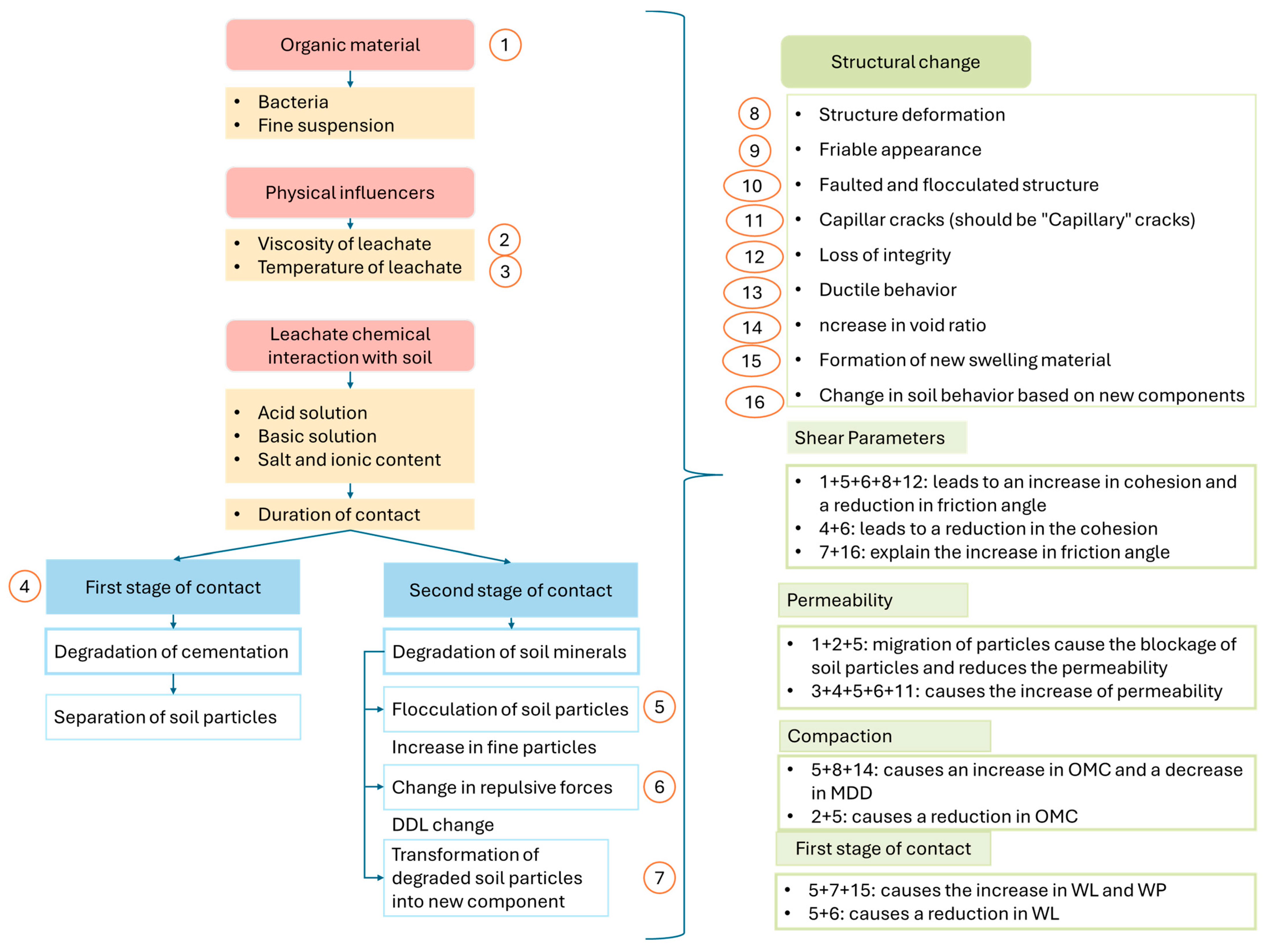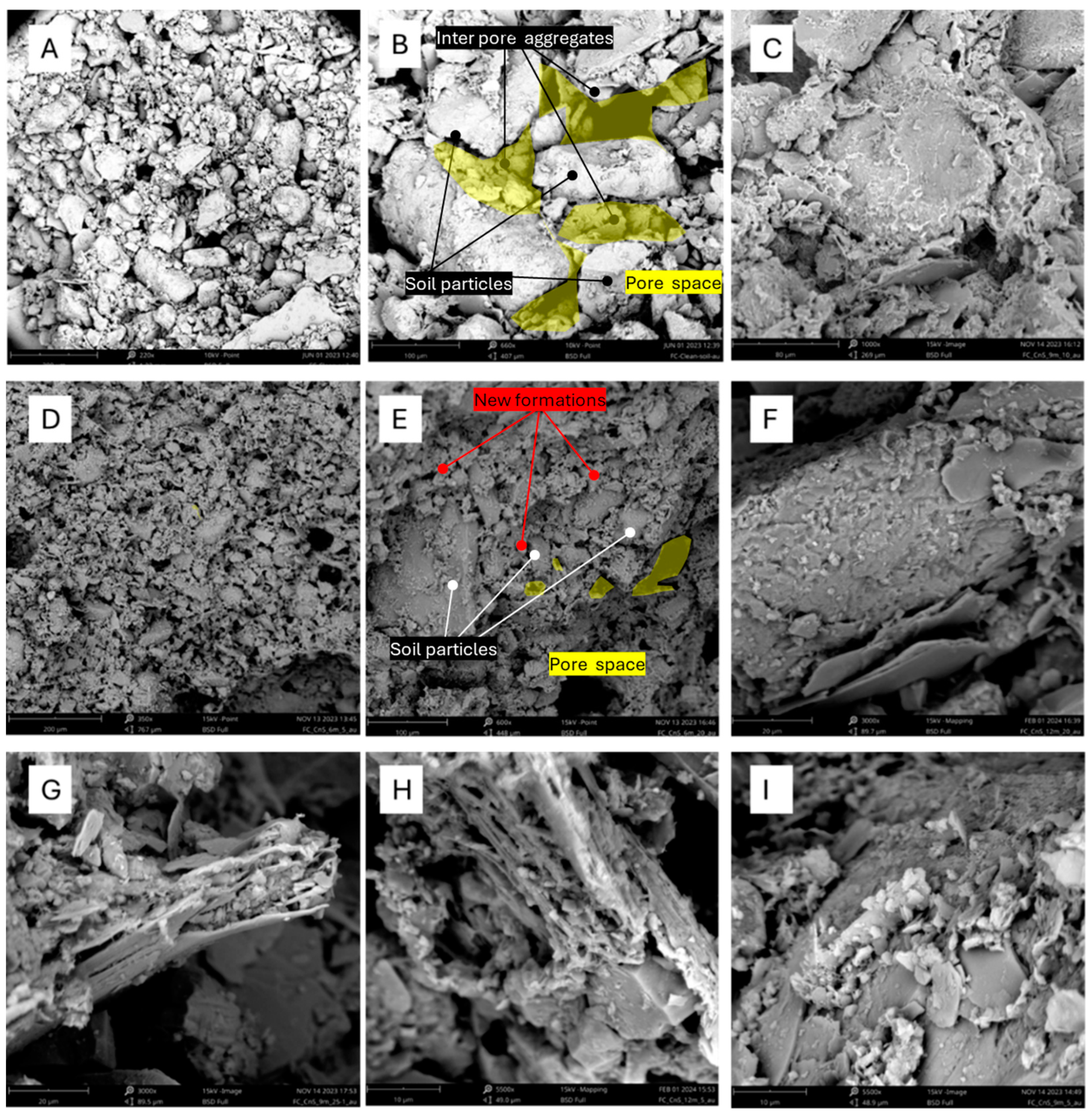Long-Term Effects of Municipal Solid Waste Leachate on Soil Hydraulic Properties
Abstract
1. Introduction
- Improving the design of containment systems in new landfills;
- Enhancing risk assessment methods for existing facilities;
- Developing more effective monitoring protocols for long-term landfill management;
- Informing remediation strategies for contaminated sites.
2. A Brief Review of Soil–Leachate Interaction
2.1. Soil Leachate Interaction Processes
2.1.1. Chemical Processes
2.1.2. Physical Processes
- Physical clogging due to suspended particles in leachate.
- Chemical clogging from precipitation reactions.
- Biological clogging from biofilm growth and microbial activity.
2.2. Effect of Leachate on Soil Geotechnical Properties
2.2.1. Effect on Shear Parameters
2.2.2. Effect on Permeability
2.2.3. Effect on Soil Compaction
3. Materials and Methods
- Contamination Levels: Soil samples were prepared with varying degrees of leachate contamination from 5 to 25% to simulate different exposure scenarios.
- Temporal Analysis: To capture the evolution of soil properties over time, tests were conducted at specific intervals: immediately after contamination, and at 1, 3, 6, 9, and 12 months post-contamination.
3.1. Leachate Characteristics
3.2. Soil Characteristics
3.3. Sample Preparation
3.4. Testing Procedures
- k is the hydraulic conductivity (m/s);
- a is the cross-sectional area of the standpipe (m2);
- l is the length of the soil specimen (m);
- A is the cross-sectional area of the soil specimen (m2);
- t is the time interval between measurements (s);
- h1 is the initial hydraulic head (m);
- h2 is the final hydraulic head (m).
4. Results
4.1. Contamination Level Effects
4.2. Time-Dependent Effects
4.3. Microstructural and Mineralogical Analysis
5. Discussion
6. Conclusions
Author Contributions
Funding
Data Availability Statement
Conflicts of Interest
References
- Raviteja, K.V.N.S.; Basha, B.M. Probabilistic Back Analysis of Koshe Landfill Slope Failure. In Proceedings of the Indian Geotechnical Conference, Guwahati, India, 14–16 December 2017; pp. 14–17. [Google Scholar]
- Ozcoban, M.S.; Tufekci, N.; Tutus, S.; Sahin, U.; Celik, S.O. Leachate Removal Rate and the Effect of Leachate on the Hydraulic Conductivity of Natural (Undisturbed) Clay. J. Sci. Ind. Res. 2006, 65, 264–269. [Google Scholar]
- Renou, S.; Givaudan, J.G.; Poulain, S.; Dirassouyan, F.; Moulin, P. Landfill Leachate Treatment: Review and Opportunity. J. Hazard. Mater. 2008, 150, 468–493. [Google Scholar] [CrossRef] [PubMed]
- Khan, S.; Cao, Q.; Zheng, Y.M.; Huang, Y.Z.; Zhu, Y.G. Health Risks of Heavy Metals in Contaminated Soils and Food Crops Irrigated with Wastewater in Beijing, China. Environ. Pollut. 2008, 152, 686–692. [Google Scholar] [CrossRef] [PubMed]
- Panarotto, C.T.; Cabral, A.R.; Lefebvre, G. Environmental, Geotechnical, and Hydraulic Behaviour of a Cellulose-Rich by-Product Used as Alternative Cover Material. J. Environ. Eng. Sci. 2005, 4, 123–138. [Google Scholar] [CrossRef]
- Langdon, K.A.; Chandra, A.; Bowles, K.; Symons, A.; Pablo, F.; Osborne, K. A Preliminary Ecological and Human Health Risk Assessment for Organic Contaminants in Composted Municipal Solid Waste Generated in New South Wales, Australia. Waste Manag. 2019, 100, 199–207. [Google Scholar] [CrossRef]
- Nayak, S.; Sunil, B.M.; Shrihari, S. Hydraulic and Compaction Characteristics of Leachate-Contaminated Lateritic Soil. Eng. Geol. 2007, 94, 137–144. [Google Scholar] [CrossRef]
- Kjeldsen, P.; Barlaz, M.A.; Rooker, A.P.; Baun, A.; Ledin, A.; Christensen, T.H. Present and Long-Term Composition of MSW Landfill Leachate: A Review. Crit. Rev. Environ. Sci. Technol. 2002, 32, 297–336. [Google Scholar] [CrossRef]
- Öman, C.B.; Junestedt, C. Chemical Characterization of Landfill Leachates—400 Parameters and Compounds. Waste Manag. 2008, 28, 1876–1891. [Google Scholar] [CrossRef]
- Bozkurt, S.; Moreno, L.; Neretnieks, I. Long-Term Processes in Waste Deposits. Sci. Total Environ. 2000, 250, 101–121. [Google Scholar] [CrossRef]
- Li, J.; Xue, Q.; Wang, P.; Liu, L. In Fluence of Leachate Pollution on Mechanical Properties of Compacted Clay: A Case Study on Behaviors and Mechanisms. Eng. Geol. 2013, 167, 128–133. [Google Scholar] [CrossRef]
- George, M.; Beena, K. Geotechnical Characteristics of Leachate Contaminated Lateritic Soil. In Proceedings of the Indian Geotechnical Conference, Koch, India, 15–17 December 2011; pp. 769–772. [Google Scholar]
- Sunil, B.M.; Shrihari, S.; Nayak, S. Shear Strength Characteristics and Chemical Characteristics of Leachate-Contaminated Lateritic Soil. Eng. Geol. 2009, 106, 20–25. [Google Scholar] [CrossRef]
- Alhassan, M. Effect of Municipal Solid Waste on Geotechnical Properties of Soils. Int. J. Environ. Sci. Manag. Eng. Res. 2012, 1, 204–210. [Google Scholar]
- Oztoprak, S.; Pisirici, B. Effects of Micro Structure Changes on the Macro Behaviour of Istanbul (Turkey) Clays Exposed to Landfill Leachate. Eng. Geol. 2011, 121, 110–122. [Google Scholar] [CrossRef]
- Shariatmadari, N.; Askari, B.; Hasan, L.; Pourya, E.; Askari Lasaki, B.; Eshghinezhad, H.; Alidoust, P. Effects of Landfill Leachate on Mechanical Behaviour of Adjacent Soil: A Case Study of Saravan Landfill, Rasht, Iran. Int. J. Civ. Eng. 2018, 16, 1503–1513. [Google Scholar] [CrossRef]
- Valencia-González, Y.; Quintero-Ramírez, A.; Lara-Valencia, L.A. A Laboratory Methodology for Predicting Variations in the Geotechnical Parameters of Soil Exposed to Solid Waste Leachates in the Field. Results Eng. 2022, 14, 100398. [Google Scholar] [CrossRef]
- Li, Y.C.; Liu, H.L.; Cleall, P.J.; Ke, H.; Bian, X.C. Influences of Operational Practices on Municipal Solid Waste Landfill Storage Capacity. Waste Manag. Res. 2013, 31, 273–282. [Google Scholar] [CrossRef]
- Li, J.S.; Xue, Q.; Wang, P.; Li, Z.Z. Effect of Lead (II) on the Mechanical Behavior and Microstructure Development of a Chinese Clay. Appl. Clay Sci. 2015, 105–106, 192–199. [Google Scholar] [CrossRef]
- Harun, S.N.; Ali Rahman, Z.; Rahim, S.A.; Lihan, T.; Idris, W.M.R. Effects of Leachate on Geotechnical Characteristics of Sandy Clay Soil. AIP Conf. Proc. 2013, 1571, 530–536. [Google Scholar] [CrossRef]
- Khodary, S.M.; Fath, H.; Negm, A.; Tawfik, A. Measuring the Engineering Properties of Landfill Leachate-Contaminated Soil in Egypt. Euro-Mediterranean J. Environ. Integr. 2021, 6, 23. [Google Scholar] [CrossRef]
- Francisca, F.M.; Glatstein, D.A. Long Term Hydraulic Conductivity of Compacted Soils Permeated with Landfill Leachate. Appl. Clay Sci. 2010, 49, 187–193. [Google Scholar] [CrossRef]
- Kanmani, S.; Gandhimathi, R.; Muthukkumaran, K. Bioclogging in Porous Media: Influence in Reduction of Hydraulic Conductivity and Organic Contaminants during Synthetic Leachate Permeation. J. Environ. Health Sci. Eng. 2014, 12, 126. [Google Scholar] [CrossRef] [PubMed]
- Cao, W.; Strounina, E.; Hofmann, H.; Scheuermann, A. Discernible Orientation for Tortuosity During Oxidative Precipitation of Fe(II) in Porous Media: Laboratory Experiment and Micro-CT Imaging. Minerals 2025, 15, 91. [Google Scholar] [CrossRef]
- Cao, W.; Yan, G.; Hofmann, H.; Scheuermann, A. A Novel Permeability–Tortuosity–Porosity Model for Evolving Pore Space and Mineral-Induced Clogging in Porous Medium. Geotechnics 2025, 5, 2. [Google Scholar] [CrossRef]
- Rowe, R. Pollutant Transport through Barriers. In Geotechnical Practice for Waste Disposal; Woods, R.D., Ed.; ASCE: Reston, VA, USA, 1987; Volume 13, pp. 159–184. [Google Scholar]
- Batchelder, M.; Mather, J.; Joseph, J. Mineralogical and Chemical Changes in Mineral Liners Incontact with Landfill Leachate. Waste Manag. Res. 1998, 16, 411–420. [Google Scholar] [CrossRef]
- Joseph, J.B.; Styles, J.R.; Yuen, S.T.; Cressey, G. Variations in Clay Mineral Performance in the Presence of Leachates. In Proceedings of the Eighth International Landfill Symposium, Sardinia, Italy, 1–5 October.
- Mitchell, J.; Madsen, F. Chemical Effects on Clay Hydraulic Conductivity. In Proceedings of the Geotechnical Practice for Waste Disposal ’87, Ann Arbor, MI, USA, 15–17 June 1987; 13, pp. 87–116. [Google Scholar]
- Sunil, B.M.; Shrihari, S.; Nayak, S. Soil-Leachate Interaction and Their Effects on Hydraulic Conductivity and Compaction Characteristics. In Proceedings of the 12th International Conference of International Association for Computer Methods and Advances in Geomechanics (IACMAG), Goa, India, 1–6 October 2008; Volume 3, pp. 2380–2386. [Google Scholar]
- Shivaraju, R.; Ravishankar, B.; Nanda, H. Engineering Properties of Soil Contaminated with Dyeing Effluent. In Proceedings of the Indian Geotechnical Conference, Koch, India, 15–17 December 2011; pp. 788–790. [Google Scholar]
- Khodary, S.; Fath, H.; Negm, A.; Tawfik, A. Measuring the Engineering Properties of Landfill Leachate-Contaminated Soil. In Environmental Science and Engineering; Springer International Publishing: New York, NY, USA, 2021; pp. 1281–1286. ISBN 9783030512095. [Google Scholar]
- Karthika, T.; Arumugam, K.; Sangeetha, R.K.; Rajesh Kumar, A. Effects on Geotechnical Properties of Soil by Leachate in Landfill Vicinity: Cauvery River, Pallipalayam, India. Mater. Today Proc. 2022, 59, 764–768. [Google Scholar] [CrossRef]
- Chihi, F.; Varga, G. Geotechnical Implications of Landfill Leachate on Soil Properties: A Comprehensive Review. In Kőzetmechanika és Termodinamika; Takács, D.M., Ván, P., Vásárhelyi, B., Eds.; Kontraszt Plusz Kft: Pécs, Hungary, 2023; pp. 179–189. ISBN 978-615-80157-8-3. [Google Scholar]
- ISO 17892-11:2019; Geotechnical Investigation and Testing—Laboratory Testing of SoilPart 11: Permeability Tests. ISO: Geneva, Switzerland, 2019. Available online: https://www.iso.org/standard/72016.html (accessed on 1 January 2025).
- Arasan, S. Effect of Chemicals on Geotechnical Properties of Clay Liners: A Review. Res. J. Appl. Sci. Eng. Technol. 2010, 2, 765–775. [Google Scholar]
- Soujanya Kamble, B.; Saxena, P.R. Environmental Impact of Municipal Dumpsite Leachate on Ground-Water Quality in Jawaharnagar, Rangareddy, Telangana, India. Appl. Water Sci. 2017, 7, 3333–3343. [Google Scholar] [CrossRef]
- Kumar, S. Municipal Solid Waste Management in Developing Countries; CRC Press: Boca Raton, FL, USA, 2016; ISBN 9781498737753. [Google Scholar] [CrossRef]








| Property | Value |
|---|---|
| Composition | |
| -Silt | 32.64% |
| -Sand | 57.50% |
| -Clay | 8.29% |
| -Gravel | 1.57% |
| Atterberg Limits | |
| -Liquid Limit (LL) | 25.5% |
| -Plastic Limit (PL) | 20.7% |
| -Plasticity Index (IP) | 4.9% |
| Physical Properties | |
| -Natural Water Content | 13.3% |
| -Solid Density | 2.66 g/cm3 |
| -Void Ratio | 0.85 |
| -Degree of Saturation | 0.31 |
| Gradation Parameters | |
| -Uniformity Coefficient (Cu) | 17.18 |
| -Curvature Coefficient (Cc) | 2.06 |
| Hydraulic Properties | |
| -Hydraulic Conductivity (k) | 6.428 × 10−7 m/s |
| Strength Parameters | |
| -Peak Cohesion (c′) | 10.3 kPa |
| -Peak Friction Angle (φ′) | 36.5° |
| -Residual Cohesion ) | 8.8 kPa |
| - Residual Friction Angle ) | 36.5° |
Disclaimer/Publisher’s Note: The statements, opinions and data contained in all publications are solely those of the individual author(s) and contributor(s) and not of MDPI and/or the editor(s). MDPI and/or the editor(s) disclaim responsibility for any injury to people or property resulting from any ideas, methods, instructions or products referred to in the content. |
© 2025 by the authors. Licensee MDPI, Basel, Switzerland. This article is an open access article distributed under the terms and conditions of the Creative Commons Attribution (CC BY) license (https://creativecommons.org/licenses/by/4.0/).
Share and Cite
Chihi, F.; Varga, G.; Kopecskó, K. Long-Term Effects of Municipal Solid Waste Leachate on Soil Hydraulic Properties. Geotechnics 2025, 5, 14. https://doi.org/10.3390/geotechnics5010014
Chihi F, Varga G, Kopecskó K. Long-Term Effects of Municipal Solid Waste Leachate on Soil Hydraulic Properties. Geotechnics. 2025; 5(1):14. https://doi.org/10.3390/geotechnics5010014
Chicago/Turabian StyleChihi, Feten, Gabriella Varga, and Katalin Kopecskó. 2025. "Long-Term Effects of Municipal Solid Waste Leachate on Soil Hydraulic Properties" Geotechnics 5, no. 1: 14. https://doi.org/10.3390/geotechnics5010014
APA StyleChihi, F., Varga, G., & Kopecskó, K. (2025). Long-Term Effects of Municipal Solid Waste Leachate on Soil Hydraulic Properties. Geotechnics, 5(1), 14. https://doi.org/10.3390/geotechnics5010014







